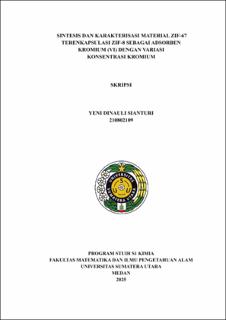Sintesis dan Karakterisasi Material ZIF-67 Terenkapsulasi ZIF-8 sebagai Adsorben Kromium (VI) dengan Vari
Synthesis and Characterization of ZIF-67 Encapsulated ZIF-8 Material as Chromium Metal Adsorbent with Variation of Chromium Concentration
Abstract
Chromium is one of the heavy metals used in the textile industry. Chromium
metal (especially hexavalent chromium) has high toxicity and is difficult to degrade in
the aquatic environment. Nowadays, adsorption technique is the most efficient
treatment in the removal of chromium pollution from water. Zeolitic Imidazole
Framework has a large surface area. The adsorption process occurs due to
electrostatic attraction followed by ion exchange. Based on the explanation above,
researchers are interested in developing ZIF-67 encapsulated ZIF-8 material to
adsorb chromium metal from a solution. The stages in this research were carried out
by synthesizing ZIF-67, synthesizing ZIF-67@ZIF-8 and adsorbing chromium (VI)
from solutions with varying concentrations of 10, 20, 30 and 40 ppm. Synthesis was
carried out by epitaxial growth method on ZIF-67@ZIF-8 material. Characterization
was performed on the material and chromium (VI) solution including FTIR, XRD,
SEM-EDX, TEM, BET and AAS testing. BET analysis on ZIF-67@ZIF-8 proved that
the pores of the material are in the micro pore range (1.1018 nm) with a surface area
of 1227.85 m2/g. SEM-EDX analysis of ZIF-67@ZIF-8 showed a rhombic
dodecahedral morphology with elemental composition of carbon, nitrogen, oxygen,
cobalt and zinc. TEM analysis results show the presence of core-shells in ZIF-67
encapsulated ZIF-8 material. FT-IR analysis of ZIF-67@ZIF-8 material shows the
presence of metal and ligand bonds at wave numbers 422 cm-1 and 690-754 cm-1; Cr
N absorption band appears at 524 cm-1 and Cr-O at 902 cm-1 after ZIF-67@ZIF-8
adsorbs chromium which proves the interaction between Cr(VI) and ZIF-67@ZIF-8
material. XRD analysis showed the crystallinity of the adsorbent and typical peaks
14.74; 16.46; 18.06; 22.17; 24.57; 26.70 showed the typical structure of ZIF-67@ZIF
8. The results of AAS analysis showed that the adsorption of chromium by ZIF
67@ZIF-8 material reached 99,13% at a concentration of 30 ppm, making it better
than adsorption by ZIF-67. ZIF-67@ZIF-8 is proven to be effective as Cr(VI)
adsorbent and has potential for waste treatment applications.
Collections
- Undergraduate Theses [1420]

